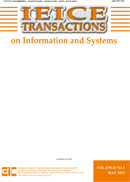
- |<
- <
- 1
- >
- >|
-
Nurmaya, Aryo PINANDITO, Yusuke HAYASHI, Tsukasa HIRASHIMAArticle type: PAPER
Subject area: Educational Technology
2023Volume E106.DIssue 8 Pages 1262-1274
Published: August 01, 2023
Released on J-STAGE: August 01, 2023
JOURNAL FREE ACCESSInvolving higher-order thinking in learning activities can produce meaningful learning. It impacts the student's ability to solve problems in new situations. Concept mapping is a learning strategy that has been proven to promote higher-order thinking. Concept map recomposition (KB-mapping) in the Kit-Build system is a closed concept mapping where learners are given concepts and links to build a concept map, and it has advantage that the recomposed map can be automatically diagnosed. It has been proven that KB-mapping improves the students' learning achievement similar to the traditional concept mapping called scratch concept map composition (SC-mapping). However, the study on the effect of KB-mapping in fostering students' higher-order thinking has yet to be evaluated. This study designed and conducted an experiment to compare the impact of KB-mapping and SC-mapping on promoting students' ability in higher-order thinking. Fifty-four undergraduate students were assigned to either KB-Mapping or SC-Mapping for learning activities. The result of this study suggested that students who learn with KB-mapping had better abilities to solve questions of higher-order thinking than those who applied SC-mapping. The findings also suggested that the quality of students' concept maps affected their performance in solving higher-order thinking questions.
View full abstractDownload PDF (2374K) -
Runde YU, Zhuowen LI, Zhe CHEN, Gangyi DINGArticle type: PAPER
Subject area: Multimedia Pattern Processing
2023Volume E106.DIssue 8 Pages 1275-1282
Published: August 01, 2023
Released on J-STAGE: August 01, 2023
JOURNAL FREE ACCESSIn order to solve the problems of copyrights infringement, high cost and complex process of rights protection in current media convergence center, a digital rights management system based on blockchain technology and IPFS (Inter Planetary File System) technology is proposed. Considering that large files such as video and audio cannot be stored on the blockchain directly, IPFS technology is adopted as the data expansion scheme for the data storage layer of the Ethereum platform, IPFS protocol is further used for distributed data storage and transmission of media content. In addition, smart contract is also used to uniquely identify digital rights through NFT (Non-fungible Tokens), which provides the characteristics of digital rights transferability and traceability, and realizes an open, transparent, tamper-proof and traceable digital rights management system for media convergence center. Several experimental results show that it has higher transaction success rate, lower storage consumption and transaction confirmation delay than existing scheme.
View full abstractDownload PDF (1205K) -
Yongsoo JOO, Yeohwan YOON, Jong Ho CHOIArticle type: LETTER
Subject area: Software System
2023Volume E106.DIssue 8 Pages 1283-1286
Published: August 01, 2023
Released on J-STAGE: August 01, 2023
JOURNAL FREE ACCESSAs ransomware inevitably overwrites existing data, SSDs can detect ransomware attacks by monitoring overwrites. The state-of-the-art technology uses a hash to monitor overwrites, which consumes tens of bytes of memory per I/O. To improve memory efficiency, we propose a bitmap-based overwrite detection method that uses only one bit per I/O.
View full abstractDownload PDF (602K) -
Jungwoo KWON, Gyeonghwan KIMArticle type: LETTER
Subject area: Artificial Intelligence, Data Mining
2023Volume E106.DIssue 8 Pages 1287-1291
Published: August 01, 2023
Released on J-STAGE: August 01, 2023
JOURNAL FREE ACCESSIn this letter, we propose a feature-based knowledge distillation scheme which transfers knowledge between intermediate blocks of teacher and student with flow-based architecture, specifically Normalizing flow in our implementation. In addition to the knowledge transfer scheme, we examine how configuration of the distillation positions impacts on the knowledge transfer performance. To evaluate the proposed ideas, we choose two knowledge distillation baseline models which are based on Normalizing flow on different domains: CS-Flow for anomaly detection and SRFlow-DA for super-resolution. A set of performance comparison to the baseline models with popular benchmark datasets shows promising results along with improved inference speed. The comparison includes performance analysis based on various configurations of the distillation positions in the proposed scheme.
View full abstractDownload PDF (5498K) -
Xingyu QIAN, Xiaogang CHEN, Aximu YUEMAIER, Shunfen LI, Weibang DAI, Z ...Article type: LETTER
Subject area: Artificial Intelligence, Data Mining
2023Volume E106.DIssue 8 Pages 1292-1295
Published: August 01, 2023
Released on J-STAGE: August 01, 2023
JOURNAL FREE ACCESSVideo-based action recognition encompasses the recognition of appearance and the classification of action types. This work proposes a discrete-temporal-sequence-based motion tendency clustering framework to implement motion clustering by extracting motion tendencies and self-supervised learning. A published traffic intersection dataset (inD) and a self-produced gesture video set are used for evaluation and to validate the motion tendency action recognition hypothesis.
View full abstractDownload PDF (726K) -
Takahiro NARUKO, Hiroaki AKUTSU, Koki TSUBOTA, Kiyoharu AIZAWAArticle type: LETTER
Subject area: Image Processing and Video Processing
2023Volume E106.DIssue 8 Pages 1296-1299
Published: August 01, 2023
Released on J-STAGE: August 01, 2023
JOURNAL FREE ACCESSWe propose Quality Enhancement via a Side bitstream Network (QESN) technique for lossy image compression. The proposed QESN utilizes the network architecture of deep image compression to produce a bitstream for enhancing the quality of conventional compression. We also present a loss function that directly optimizes the Bjontegaard delta bit rate (BD-BR) by using a differentiable model of a rate-distortion curve. Experimental results show that QESN improves the rate by 16.7% in the BD-BR compared to Better Portable Graphics.
View full abstractDownload PDF (1241K)
- |<
- <
- 1
- >
- >|